Zorn: A Swedish Superstar
Reviewed by Anna-Maria HällgrenAnna-Maria Hällgren, PhD
Department of Culture and Aesthetics, Stockholm University
anna-maria.hallgren[at]arthistory.su.se
Citation: Anna-Maria Hällgren, exhibition review of Zorn: A Swedish Superstar, Nineteenth-Century Art Worldwide 20, no. 3 (Autumn 2021), https://doi.org/10.29411/ncaw.2021.20.3.24.
This work is licensed under a Creative Commons Attribution-NonCommercial 4.0 International License  unless otherwise noted.
unless otherwise noted.
Your browser will either open the file, download it to a folder, or display a dialog with options.
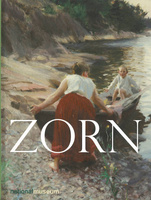
Zorn: A Swedish Superstar
Nationalmuseum, Stockholm
April 6–August 29, 2021
Catalogue:
Carl-Johan Olsson, ed., with Susanna Pettersson, Johan Cederlund, Vibeke Bröstorp, Markus Bertsch, Elizabeth Doe Stone, Patrik Steorn, Per Hedström, Matrin Olin, and Pedro Westerdahl,
Zorn: A Swedish Superstar.
Stockholm: Nationalmuseum, 2021.
176 pp.; 231 color illus.; appendix; bibliography; notes; references; exhibition checklist.
$40 (hardcover)
ISBN: 978–91–7100–906–7
After visiting the exhibition Zorn: A Swedish Superstar at the Nationalmuseum in Stockholm, I was reminded of an earlier visit to the artist’s home in Mora. Zorn placed the lights in the dining room there directly above the rear end of the table, where he sat. This might very well have been mere chance, or for practical reasons, but in hindsight it reminds us that Zorn was well aware of being a superstar in the spotlight. As an artist however, Zorn managed perfectly well to shine on his own. This becomes clear during a visit to the exhibition.
A great part of the artist’s work has been on the move over the last years, showcased in places such as Paris, New York, San Francisco, and the Hague.[1] But even so, the exhibition in Stockholm—postponed due to the Covid-19 pandemic—has been eagerly awaited. When the doors finally opened one year later than planned, the exhibition almost—but not quite—marked the 100th anniversary of Zorn’s death. Visits to the exhibition have been strictly regulated in line with the Swedish Public Health Agency’s recommendations. Each visitor needs to pre-book tickets not only for a specific day, but also for a specific time slot. Inside the exhibition, visitors are instructed to follow a strictly planned route indicated by pink arrows on the floor. Despite the impossibility of strolling around in a carefree manner, there is an advantage to these regulations: the possibility to easily study works on display often in small rooms that otherwise might have been crowded.
As the exhibition also reminds us, the life of Anders Zorn resembles a rags-to-riches-story. An illegitimate son of a working-class woman and a German brewer, Zorn had a simple upbringing in Dalarna. After studying at the Royal Academy of Fine Arts, made possible thanks to financial support from various benefactors, he soon met with artistic recognition when the watercolor In Mourning (1880) attracted attention with its melancholic image of a woman’s face partially covered by a mourning veil. The exhibition makes the early refinement of Zorn’s technique clear by placing this painting next to a later and more confident version. During the second half of the 1880s he made his first devoted effort in oil painting, which resulted in an intimate portrait of his wife Emma Zorn, simply entitled Emma Reading (1887). At the same time, his often anecdotal motifs, quite popular in the illustrated press at the time, gave way to a conceptually more stimulating approach. Zorn began to explore light and the modern urban experience in tandem with the themes closest to his heart, such as the rural landscape of Dalarna. He soon became a man of the world, claiming his place in the milieus that mattered the most for critical and financial success: world exhibitions, the Salon, and Galerie Durand-Ruel in Paris. In this regard, his wife—always more than a mere muse—opened several doors while keeping a steady eye on his artistic production, becoming “a kind of managing director in what can be regarded as the Firm of Anders Zorn” (12). Zorn often draws comparisons to other well-known artists such as John Singer Sargent. Like Sargent, Zorn became a highly sought-after portrait painter, but he also established himself as a plein-air artist, capturing the rural landscape around him, and as a painter of female nudes, often criticized for their voyeuristic and even pornographic qualities.
The exhibition is roughly divided in two parts. The first covers the period from Zorn’s early, formative years from the 1880s to the turn of the century. The second includes works from the latter part of his career to its end in 1920, when Zorn died at Mora Hospital at the age of sixty. All in all, more than 200 works are showcased, mainly paintings in oil and watercolors but also etchings and a few sculptures. Several works belong to the Nationalmuseum’s own collection. Additionally, the collection of the Zorn Museum in Mora is well represented, as well as works from private collections that are seldom, if ever, put on display. Thus, a number of Zorn’s best-known works, such as the boldly painted La Parisienne (1891; fig. 1), the vibrant Midsummers Dance (1897), and the pretentious yet introspective Self-Portrait in Red (1915; fig. 2) hang beside less familiar works. The majority of the works are framed by sober pastel wall colors, often picking up nuances in the paintings, such as lavender, pink, and mauve, against a soft, gray background. The walls of the very last rooms pop out in this regard, as they are partially painted in highly saturated greens and reds, corresponding to recurring colors in Zorn’s paintings but also underlining his roots in Dalarna and its folk culture at the time (fig. 3).
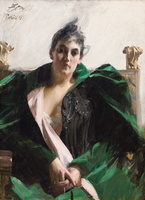
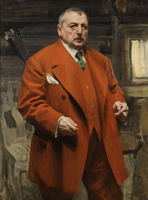
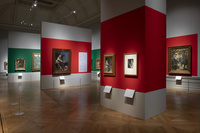
The impressive scale of the exhibition has both benefits and drawbacks. While it offers an opportunity to see works seldom on display, the sheer number of pieces and their variety in terms of technique, motifs, and quality presents certain curatorial challenges. The exhibition is thematically organized, with no less then twenty-five different themes. After entering the exhibition, Zorn’s paintings from the Stockholm Archipelago from the late 1880s meet the visitor’s eye under the banner “Dalarö” (fig. 4). At the time, the many islands in the Stockholm Archipelago were often visited by artists and writers, such as Carl Larsson, Bruno Liljefors, and August Strindberg. Zorn visited them too because his mother-in-law was in the habit of renting a house on one of the most well-known islands, Dalarö. Here, Zorn created a number of paintings—watercolors as well as oils—attempting to capture the spirit of the Archipelago. These works are filled with light, such as in the painting Outdoors (1890; fig. 5) in which a warm play of light connects the young women with the cliff, the water, and a high-reaching tuft of grass. The many nudes differ from the nudes in Zorn’s later works. Seldom posing, they have been depicted in the midst of everyday activities. In Mother Dressing her Child (1888) a woman with patches of light on her back dresses her child under a tree next to the sea (fig. 6). In the painting Archipelago Bay–Light Summer Breeze (1889), it is possible to not even notice the woman getting dressed in the top right corner were it not for a small streak of red next to her that draws our attention.
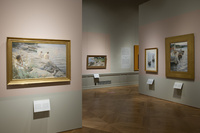
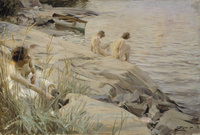
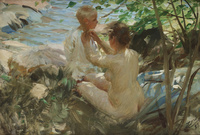
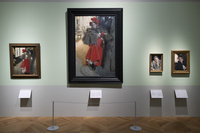
Pink arrows lead from this gallery to one filled with paintings capturing Parisian street life, offering a dramatic contrast in motif as well as spirit. Under the headline “Parisian Lighting” the visitor stumbles upon well-known works such as the portrait of a woman riding the omnibus, Omnibus I (1890), and Night Effect (1895), a full-length portrait of a woman dressed in bright red (fig. 7). The composition of the latter work is slightly unbalanced which corresponds to the vague distortion of the face of the woman and the odd placement of her body. The light is very different from that in the Dalarö paintings, as it is produced by the electric and gas lights of the city rather than the sun. In contrast to the bare skin in the paintings from Dalarö, the figures in the paintings from Paris are dressed in layers and layers of heavy cloth, as if armored.
While contrasts such as these effectively highlight the breadth of the artist’s motifs, a clearer framing as well as contextualization of the works on display would have been welcome. The artist is seldom anchored well enough in time and place. Thus, Zorn’s many travels to places such as the Alhambra, Istanbul, or London become merely geographical coordinates rather than places of specific cultural importance. The visitor is assumed to be fairly well-versed in late-nineteenth-century visual culture, such as knowing what the Salon in Paris was or being acquainted with the cultural and political importance of the world exhibitions at the time.
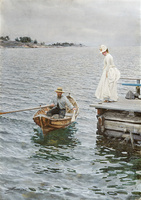
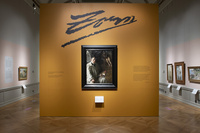
Zorn’s often-noted technical skills are sadly seldom explored in detail in the wall text. The exhibition simply notes that Zorn was a great painter, able to use exact brushstrokes as well as bold and rapid ones, and to work with watercolors as well as oil. But there is, of course, more to the story. If his technical skills resulted in an ability to render depictions true-to-life, as in the watercolor Summer Vacation (1886; fig. 8), certain works from the 1890s in particular demonstrate another kind of skill: depictions true-to-life, not in the sense of how things look, but how they feel: the warmth of the sun, of the fire, the home; the movement of a dance floor; a fashionable London haunted by smog. The artist often successfully limited himself to what has been called “the Zorn Palette”: flake white, ivory black, yellow ochre, and vermillion. It is the very same palette that figures in the painting that opens the exhibition, Self-Portrait with Model (1896), an intriguingly arranged work in which a bold interplay between lightness and darkness creates a sense of depth (fig. 9). Zorn also daringly experimented with thin as well as thick color applications, sometimes using heavy impasto next to hands and faces in order to create a sense of depth. Yet another technical move worth mentioning is how he transferred supposedly medium-specific traits to other mediums. The directness of his more mature watercolor paintings recurred in oil; the brushstrokes through which he created volume in his oil painting can be distinguished in his etchings. Technical skills and manners of this kind might be considered obvious, but are likely not so to most visitors. A more thorough and enlightening discussion could have enabled visitors to notice more than, say, the lifelike glittering of the sea, such as in the previously mentioned Summer Vacation. It is also hard to deny that the almost chronological order makes it harder to follow the artist’s technical developments.
To a certain extent, the colorful catalogue, which consists of a brief introduction and nine short chapters, compensates for the shortcomings touched upon above. The first chapter is by the curator of the exhibition, Carl-Johan Olsson, and offers a biographical overview and a few more elaborate, technical notes. Per Hedström addresses the artist’s interest in and use of photography, which is most welcome since the exhibition itself does not include photographs at all. Among the photographs reproduced in the catalogue is an image of Zorn in front of the well-known Mora Market (1892), in which the strict distribution of the picture plane effectively contrasts with the subject matter of the painting: a young woman sitting in the grass, wearily waiting for her drunken fiancé to sober up, his whole body and face flat on the ground. Yet another photograph in the catalogue pictures Zorn naked in the bathtub, possibly included as a nod to the many bathing women he painted and, for better or worse, has become deeply associated with.
The catalogue is informative but rehearses well-worn material. Several of the texts recount familiar stories: the narratives about the cosmopolite who never lost sight of the rural landscape of his home region, or who had a weak spot for indulging in women, food, and alcohol. A particularly refreshing take, however, is offered by Pedro Westedahl in his chapter on the economically successful partnership between Zorn and Bukowskis in the 1910s. The auction house held a monopoly on the artist’s etchings and began promoting them as “better investments than regular stocks and shares” (152). Placing Zorn within this specific economic context—a context the curator also touches upon in the very first chapter of the catalogue—might very well be a starting point for another exhibition.
One could argue that an analytically more intriguing presentation of the artist and his work would have missed the mark, because the exhibition is probably intended to be a blockbuster. Still, it is not necessary for an exhibition to be intellectually difficult for it to be thought-provoking, and it would be worthwhile for this exhibition to explore its own premises. What was it exactly, for example, that made Zorn into a “superstar”? Are the works by Zorn meant to speak for themselves in this regard? And what is truly the aim of the exhibition, apart from yet again giving Zorn “time in the limelight” (7)?
Notes
[1] Anders Zorn – Le maître de la peinture suédoise, Petit Palais, Paris (2017); Anders Zorn: Sweden’s Master Painter, Fine Arts Museums, San Francisco (2013) and National Academy Museum, New York (2014); Anders Zorn: De Zweedse idylle, Gemeentemuseum Den Haag, The Hague (2020–21).